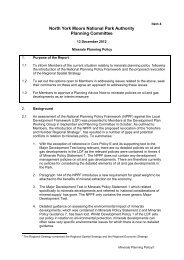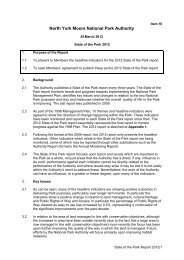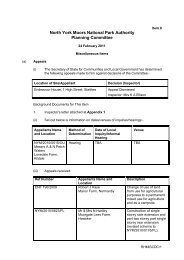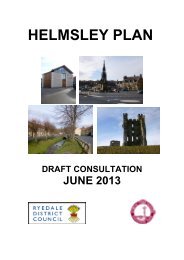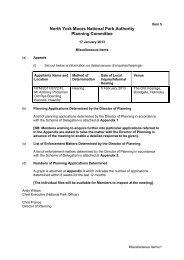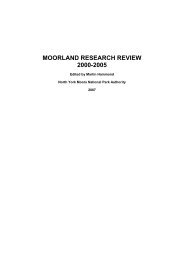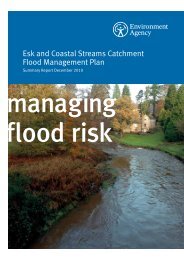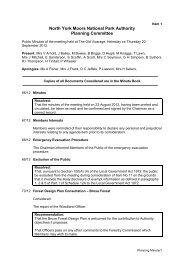Management Plan - North York Moors National Park
Management Plan - North York Moors National Park
Management Plan - North York Moors National Park
Create successful ePaper yourself
Turn your PDF publications into a flip-book with our unique Google optimized e-Paper software.
3. Understanding and Enjoyment<strong>National</strong> <strong>Park</strong>s are for everyone. The freedom to exploreand enjoy beautiful landscapes was a major impetus behindthe creation of <strong>National</strong> <strong>Park</strong>s and this was embodied in thesecond statutory purpose for <strong>National</strong> <strong>Park</strong>s:b To promote opportunities for the understanding andenjoyment of the special qualities of the <strong>Park</strong>s by thepublic.BMore recently, the <strong>National</strong> <strong>Park</strong>s Circular emphasises theimportance of people in the environment and the rolethat these protected landscapes play in promoting social,economic, spiritual and physical wellbeing.Every year, millions of people make use of the recreationalopportunities provided by the <strong>National</strong> <strong>Park</strong>’s environment,from a day’s walk or school visit to a multi-day sightseeing ormore adventurous mountain biking visit. Not only does thisprovide benefits in terms of the health and well-being of thepopulation, it also enhances understanding and knowledgeof the <strong>National</strong> <strong>Park</strong> and the environment as a whole and isa major factor in the local economy. However, the benefitspeople gain from being in the <strong>Park</strong> do not need to beassociated with undertaking an ‘activity’. The fact that thelandscape is designated creates a sense of inherent value andjust being in the <strong>Park</strong> can offer people a sense of calm, peaceand tranquillity and a rejuvenation of spirit.The proximity of large urban areas, particularly to the north ofthe <strong>Park</strong>, highlights its importance in providing opportunitiesfor recreation.3.1 A Sustainable Growth in Visitors for the<strong>National</strong> <strong>Park</strong>During 2010, 10.2 million visitor days were spent in and aroundthe <strong>National</strong> <strong>Park</strong>, comprising 6.4 million visitors 37 . Since thepublication of the last <strong>Management</strong> <strong>Plan</strong> in 1998, there hasbeen an average growth in visitor days by approximately 1-2%each year. During this period, there have been fluctuations bothup and down, however, the most recent period from 2007-2010 has seen a drop of 5% (half a million) in visitor days and5% (350,000) in visitors. Current estimates indicate that if thistrend were to continue a further 4.5% of visitor days and 5.5%of visitors would be lost from 2010 through until 2015 38 . Incontrast, the number of visitors to the <strong>York</strong>shire and Humberregion has increased over recent years by around 6% 39 .Given the benefits which tourism brings in terms of raisedawareness of the special qualities and the opportunity to enjoythe <strong>National</strong> <strong>Park</strong> as well as the financial benefits to the localeconomy, a reduction in tourist days would be seen as having anoverall negative impact on the <strong>National</strong> <strong>Park</strong>.VisitEngland’s Strategic Framework for Tourism 40 proposes theprinciples of ‘wise growth’ and identifies a headline ambition of3% real growth in the value of tourism in England year on yearbetween 2010 and 2020. This is growth in the economic value oftourism rather than in visitor numbers.If this ambitious growth rate is achieved for England and mirroredin an increase in the value of tourism for the <strong>North</strong> <strong>York</strong> <strong>Moors</strong>,we anticipate that this might mean an increase on 2010 figuresof 1.6 million visitor days (to 11.9 million) and around 1 millionadditional visitors (to 7.5 million) between 2010 and 2015 in the<strong>National</strong> <strong>Park</strong> 41 . The <strong>National</strong> <strong>Park</strong> has already experienced apeak of 10.8 million visitor days in 2007 without major impacton the special qualities.During the summer months, there are some places in the<strong>National</strong> <strong>Park</strong> where current visitor levels do cause congestionand disturbance. However, there are many other places andother times of year when the <strong>National</strong> <strong>Park</strong>, its communities andits businesses have the capacity to sustain more visitors thancurrent levels.It is impossible to arrive at a precise measure of what level ofvisitation an area can withstand before communities, othervisitors or the landscape and wildlife are negatively affected.The more diverse the area and the wider the range of visitor itreceives, the more difficult it is to make an accurate forecast ofthe capacity of that area to sustain a certain number or type ofvisitor.The current level of damage and disturbance caused by recreationand tourism is very limited and very localised. There is experienceof managing visitors and facilities to lead to more sustainablerecreation. There is spare capacity at tourism based facilities suchas hotels, youth hostels and camp sites. From this it is considered37 Scarborough Tourism Economic Activity Monitor 2010 Report(Global Tourism Solutions (UK) Ltd, 2011)38 To project further than a 5 year period is not deemed accurateenough, hence revised projections will be calculated in around 3years for the following 5 year period of the <strong>Management</strong> <strong>Plan</strong>39 Great Britain Travel Survey / Welcome to <strong>York</strong>shire, data on VisitorTrends by Purpose of Trip 2006 – 2010.40 England – A Strategic Framework for Tourism 2010 – 2020(VisitEngland, 2011)41 Scarborough Tourism Economic Activity Monitor Projections(Global Tourism Solutions (UK) Ltd, 2011)<strong>North</strong> <strong>York</strong> <strong>Moors</strong> <strong>National</strong> <strong>Park</strong> <strong>Management</strong> <strong>Plan</strong>63




